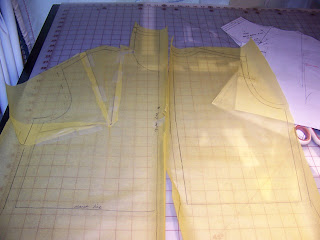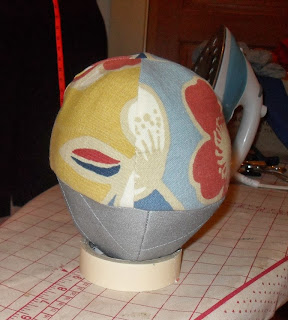After a conversation or two online, I felt I needed to clarify my pocket procedural.
I used a version of this in
Plaidness, but it doesn't illustrate what I'm trying to say. I like my real fabrics to coordinate, if not to match exactly. If you are using a matching plaid for a welt, all that flipping and pinning I did in Plaidness is the way to go. I am sure I will figure out a better way to do that, but not today.
The drawings are not fancy, but this way, the right and wrong sides of the fabrics are clearer.
Garish, but clearer.
First, you need to cut a bigger piece of pocket material than you think you're going to need. My drawings here result in a too tiny pocket (as you will see by drawing F).
With the right sides of the pocket material and the object of pocketing facing each other. You want to sew two lines of stitching where you want the pocket opening to be. They are the top and the bottom.
The green line is the cut line to open the hole. You want to make the triangly part as long as you can stand it.
Turn the fabric through the hole you just made. The green triangles in B show where you're pulling those bits through to the sides between the layers (xray vision time!). Iron now. Drawing C shows folding up the bottom part to just cover the hole. Iron it in place.
You want to sew (the red line) in the ditch on the right side across the opening and ONLY across the opening in the ditch. This involves pinning on this inside and turning it to the right side and probably repinning (and then removing the pins from the wrong side). Lots of pinning.
This is where I mention that you want to keep all of this as flat as possibly.
Back on the wrong side, drawing E, iron again. Then bring up the bottom edge of the pocket to meet the top edge and sew them to each other (making a tube). If the pocket is square enough, this should work. If it's way off, you'll need to trim it.
I like the pocket seam to be up and towards me, not at the bottom. The pockets seem to wear better this way. That's why that seam is in the middle (perhaps too high but this shows why you want to use a BIG piece of pocket stuff for this. You will use it all).
I slide a piece of plastic in between the layers I want to pin and the ones I don't. Which comes in handy in drawing F. I iron again, slide the plastic under the end, pin it, pin the other end, and sew as indicated by the up and down red lines. I only sew the pocket material, not the facing or the front. No, I'm not sewing right next to the welt. It's going to pull and distort the back of the pocket with too much handling.
Flipping back to the front with drawing G, I finish it up by sewing in the ditch on the ends of the welt (the red lines) through all layers to secure. Kinda covers the part where I did not sew the pocket sides that close to the welt.
Nice things about this application; if I use a big enough piece for the pocket, I'm not stuck if I miss-cut. I like to use the lining for the welt, but if I don't, I can stick a front fabric patch to cover where the flap covers the hole on the pocket fabric piece. I can pull something through the welt flap to make it stiffer/puffier/I can keep the construction as flat as possible for as long as possible. I can reinforce the pocket bottom if I decide halfway through that I should have done that.
I like a process that lets me mess up, fix it, change my mind and use all those pins I bought.
Hope this works for you, too.








































